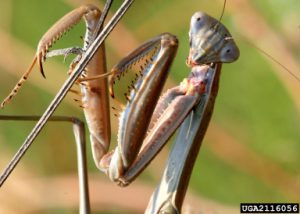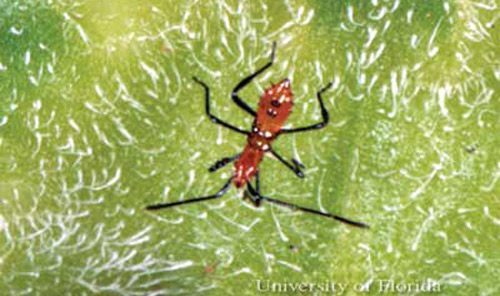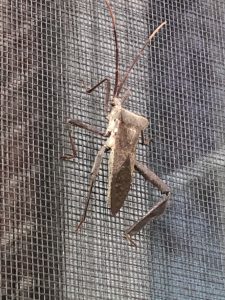
by Mary Salinas | Aug 18, 2021
For those of you who tuned into the July 29 edition of Gardening in the Panhandle LIVE, beneficial insects was the topic of the day. Here are links to the publications our panelists talked about.

Mantid. Photo credit: David Cappaert, Bugwood.org.
How do I identify the kind of insect I have?
Recognizing beneficial bugs: Natural Enemies Gallery from UC Davis http://ipm.ucanr.edu/natural-enemies/
How to distinguish the predatory stink bug from the ones that harm our crops: https://entomology.ces.ncsu.edu/wp-content/uploads/2014/01/FL-pred.jpg
How to tell difference in stink bugs and leaf footed insects. Are both harmful? UF/IFAS Featured Creatures: leaffooted bug – Leptoglossus phyllopus (Linnaeus) (ufl.edu)
How can I tell bad beetles from good ones? Helpful, Harmful, Harmless Identification Guide is one resource available: http://ifasbooks.ifas.ufl.edu/p-153-helpful-harmful-harmless.aspx
How can we encourage beneficial insects?
How can we encourage the beneficial insect species?
- Plant more flowers attract pollinators that also feed on insects.
- Diversity of plants in the landscape.
- Use softer or more selective pesticides to minimize damage to beneficials.
Is it helpful to order beneficial insects such as lady bugs? Encouraging Beneficial Insects in Your Garden OSU: https://catalog.extension.oregonstate.edu/sites/catalog/files/project/pdf/pnw550.pdf
How effective is buying predatory insects to release in your greenhouse? Natural Enemies and Biological Control: https://edis.ifas.ufl.edu/publication/IN120
Can I buy beneficial insects to start breeding in my garden? Natural Enemy Releases for Biological Control of Crop Pests: https://www2.ipm.ucanr.edu/agriculture/natural-enemy-releases-for-biological-control-of-crop-pests/
What benefit would result by planting city right-of-ways with native wild flowers? https://edis.ifas.ufl.edu/publication/in1316; https://adamgdale.files.wordpress.com/2020/03/gcm_feb2020.pdf
Can an individual gardener sustain an ecosystem for beneficial insects? Penn State Article on beneficial insects that mentions some flowering plants that help support predators and parasitoids: https://extension.psu.edu/attracting-beneficial-insects
Specific Insects
How do I get rid of mole crickets? UF/IFAS Mole Crickets: https://edis.ifas.ufl.edu/entity/topic/mole_crickets
Are wasps really beneficial? Beneficial Insects: Predators!: https://sfyl.ifas.ufl.edu/sarasota/gardening-and-landscaping/horticulture-commercial/integrated-pest-management/beneficial-insects/
Is a dish soap solution effective against wasps? Soaps, Detergents, and Pest Management: https://gardeningsolutions.ifas.ufl.edu/care/pests-and-diseases/pests/management/soaps-detergents-and-pest-management.html
How to control leaf footed bugs? Handpick them, attract beneficials, create diverse plantings in landscape, accept some damage, and control them when in the juvenile stage.
Can you tell me about praying mantids? Praying Mantids: https://entomology.ca.uky.edu/files/efpdf2/ef418.pdf
Are there any beneficial insects that keep mosquito populations down? Dragonfly larvae in water, mosquitofish
What are the little insects that hop out of centipede grass? Are they beneficial?
Spittlebugs and your lawn: https://nwdistrict.ifas.ufl.edu/hort/2020/05/27/spittlebugs-and-your-lawn/
How to stop Eastern Black Swallowtail Butterflies laying eggs on parsley – the hatched caterpillars eat it all. Plant extra or put a screen over plant.
Extra fun video!
Take a look at this video of parasitic wasp attacking aphids: Parasitic Wasps | National Geographic – YouTube

by Matthew Orwat | Mar 25, 2021
Stinkbugs and their relatives are not always problematic in the flower or vegetable garden, but when they become so, they can suck the life out of our fruits and vegetables, create ugly abrasions, and destroy flowers such as roses.

Over-wintering adult leaffooted bug emerging from hibernation . Image Credit Matthew Orwat, UF / IFAS Extension

The green stink bug Acrosternum hilare (Say). Image and caption credit EDIS, Dr. Russ Mizell
What is a Stink Bug?
The stink bug (Pentatomidae family) is a major garden pest of a variety of fruits and vegetables including squash, peppers, tomatoes, peaches, plums, pecans and a variety of other edibles. They are known as a “piercing and sucking” insect because that’s the way they feed, by using their mouth, or proboscis, just like a needle to pierce the fruit and suck out the juices. This feeding leaves a damaged area of the fruit which may develop discoloration, rot or fungal disease and render the fruit unsaleable or inedible.
Who are “their relatives”
The leaf footed bug, Leptoglossus phyllopus (L), is a relative of the stinkbug and feeds in the same way, has a similar lifecycle and causes similar damage. They are usually slightly larger and have “leaf like” appendages on their legs which are their namesake.
What is their lifecycle?
In Florida, overwintering adult stink bugs will place a clutch, or tight group of eggs, on a host plant early in the growing season. If their preferred plant is not available, they use a variety of weeds and grasses to lay eggs upon and provide food for their young. After eggs hatch, they go through several nymph stages before they finally reach the adult stage. Stink bugs have multiple generations in a year, often four to five. They readily move to find preferable food sources and might appear in a garden without warning to feed and cause destruction.

Nymph of the leaffooted bug, Leptoglossus phyllopus (L.). Photograph by Lyle J. Buss, University of Florida.
How are they best controlled?
First of all, many stink bugs use weeds as host plants to gather and feed upon, so controlling weedy plants around vegetable and fruit gardens might limit their numbers. If stink bugs are a major problem, planting trap crops, such as sunflowers, is beneficial. Stink bugs prefer to feed on sunflowers more than some other vegetables. This situation can be used to the gardener’s advantage by mechanically killing or spraying stink bugs on trap crops while avoiding treating food crops with pesticides. More information on trap cropping can be found here.
Additionally, stink bug traps are available. These mechanically trap stink bugs, thus reducing their numbers in the garden, but need to be monitored and serviced regularly. Several species of parasitic Tachinid flies are also predators of stink bugs. These flies lay their eggs on adult stink bugs. The fly larva use the bug as a buffet, slowly killing the bug.
Stink bugs are difficult to control with insecticides, but some measure of control can be achieved at their nymph stage with various approved fruit and vegetable insecticides containing pyrethrins. These products are readily available at local garden centers and feed & seed stores.
For more information, please check out the following resources:
by Alex Bolques | Nov 25, 2013

In search of an entry point into a home: Leaf footed bugs congregating on house siding in search of a warm sheltered environment to spend winter. Courtesy of Bill Stinson
Leaf footed bugs are pests of many seed, fruit, vegetable and nut crops. They get their name from the leaf shape of their back legs. The insect is dark brown to black and about an inch long. Like ladybird beetles, leaf footed bugs can invade your home in the fall in search of a warm sheltered environment to spend winter. In some cases, this may be inside your home. However, unlike ladybird beetles, which can invade a home by the hundreds, leaf footed bugs numbers are considerably less.
In both cases, they enter the home through openings such as cracks, crevices, crawl spaces, attics, ridge vents etc. Once inside, they do not cause any damage, eat, drink or reproduce. Instead, they go into what is called diapause, a dormant state. If you encounter them in living spaces of the home, a common management practice is to collect them by hand or mechanically by removing them with a vacuum cleaner and then releasing them outside. Leaf footed bugs are related to stink bugs and will give off an odor if crushed or held to long in your hand. Once spring arrives, they will become active and you may find them roaming around living spaces again. Use the same control tactic to help them find their way to the outside of the home.
It should be noted that ladybird beetles are considered a beneficial insect that feeds on crop-damaging insects such as aphids, mealy bugs, and white flies. On the other hand, leaf footed bugs are a serious pest of cotton and a direct pest of many seed, fruit, vegetable and nut crops.
Reference
Stink Bugs and Leaf-footed Bugs Are Important Fruit, Nut, Seed and Vegetable Pest






